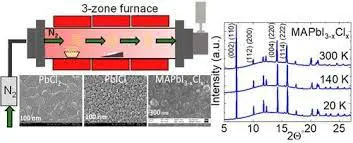Solar cell material is a new materials with tremendous possibilities for light harvesting and emission include solar cells, TVs, and display screens. In a recent study, scientists discovered a novel method for improving the performance and stability of a specific subtype of these materials known as perovskites. The study’s findings were presented in an article that was published in ACS Applied Electronic Materials.
A novel technique for creating hybrid perovskites has been developed by researchers from the University of Missouri in cooperation with researchers from the University of Western Cape in South Africa and physicists from the U.S. Department of Energy’s (DOE) Argonne National Laboratory. These materials are a mix of organic and inorganic semiconductors that may serve as the foundation for brand-new solar cells or other electrical gadgets.
According to main author and MU professor Suchismita (Suchi) Guha, “Organic-inorganic hybrid perovskites have grown more intriguing to the materials and electronics communities, especially during the past 10 years or so.” “They can now be as effective as solar cells made of silicon in some situations. They may be utilized and modified for a wide variety of applications and are also considerably more adaptable than silicon.”

The procedures for creating lead halide perovskites were improved by Guha and her associates. Previous methods for producing these thin-film perovskites needed solvent-based liquid processing, rendering the films vulnerable to deterioration when exposed to air. Additionally, one of the molecules would have a structural change during the previous manufacturing process, resulting in performance restrictions under actual operating circumstances.
By using the novel method, the scientists were able to stop the transition and maintain the afflicted molecule’s stable structure throughout a wide temperature range. Furthermore, the new method made the perovskite air stable, fitting it for a possible solar cell.
“Many studies have examined strategies to try to improve the stability of hybrid perovskites, including diffusion barriers, additive engineering, and chemically inert electrode optimization, but this is one of the first studies to look at the growth method itself as a way to boost the final performance of the device,” Guha said.
Argonne scientist Evguenia (Jenia) Karapetrova and Guha employed X-ray diffraction studies at Argonne’s Advanced Photon Source (APS), a DOE Office of Science user facility, to validate the molecular structure of the perovskite material.
The ability to define the perovskite structure at the APS offers a special window into the potential of this useful material, according to Karapetrova.
Guha claimed that the secret to better gadget performance seems to be to avoid phase changes. “We illustrate the road to an enhanced and possibly usable perovskite by keeping a stable structure across the operational temperature window.”
Read More
- A secure global supply chain is possible with blockchain.
- Using electricity to locate materials that can “learn” is shocking to the system
- Cracking of Eggshells using computing power
- A Way To Help Reduce Global Warming Is Through Solar Energy Conversion
Conclusion
The solar cell can both harvest and emit light offer exciting potential for technologies that range from solar cells to TV and display screens. This was detected by the scientist. you can drop your comment on the comment section



